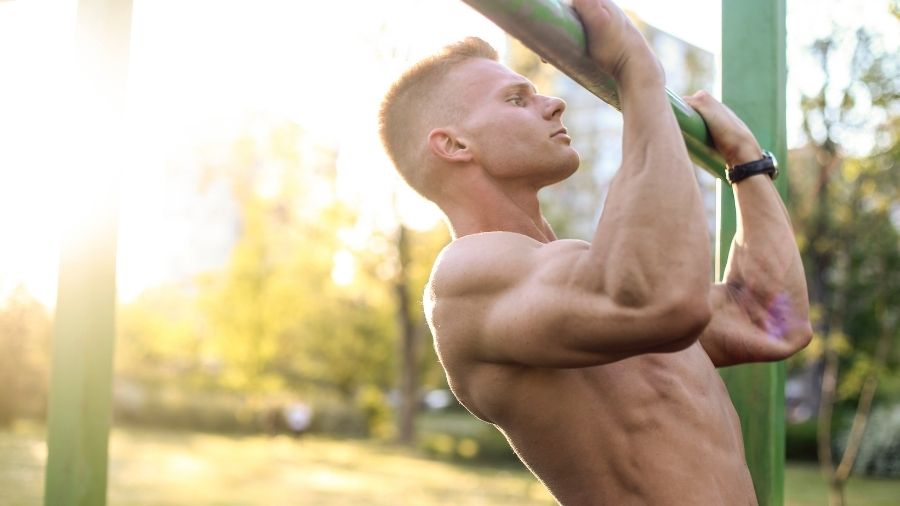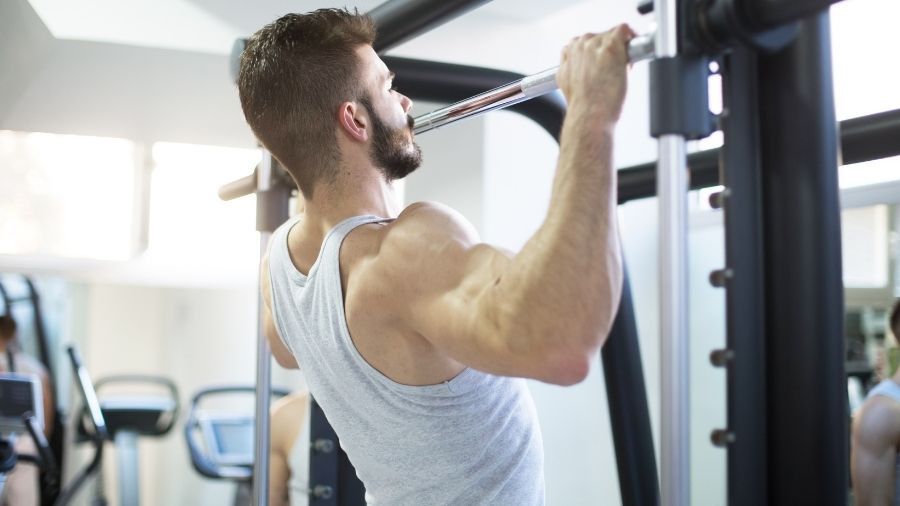The pull-up is considered one of the greatest tests of upper body strength. There’s a reason it’s used in many physical performance tests such as the army and within various sports. While most trials will standardize the pull-up grip, is there a best pull-up grip you should use within your training?
The best pull-up grip is a medium-width, pronated false grip for targeting the lats. The underhand grip is best for targeting the biceps. The neutral and underhand grips are easiest for pull-ups.
But there’s more to the way you grip when it comes to pull-ups. And it’s essential to understand why certain grip positions are better than others. What better way to find out than science!
Table of Contents
Best Pull-Up Grip For Back
The pronated (overhand) grip is the best for targeting your back muscles. Particularly the lats. The pull-up elicits the most significant activation of the lats compared to any other back exercise [1]. Why is the pronated grip so effective? Because it places the biceps into a disadvantageous position so they can’t contribute much to the exercise.
Placing most of the stress on the back muscles to perform the movement. But the position of your hands isn’t the only thing you need to think about. How wide you grip your hands will also play a significant role in building a wide back with pull-ups.
A medium grip width is the best grip width for maximizing back development with pull-ups. It allows you to lift the most weight and is the perfect trade-off between weight lifted and lat range of motion [2].
Here is an example of what a wide grip width looks like:
Moving your hands in so they are inside the angled part of the pull-up bar is where most lifters’ medium grip will lie. I like to have my pinky finger on the slope.
Finally, we must address how you grip the pull-up bar. A false grip (thumb over) is the best way to grip the pull-up bar. Anecdotally, it reduces the involvement of the forearms and upper arms so you can focus on your lats and back muscles.
Further, it allows you to pull with your pinky fingers, providing a better mind-muscle connection with the lats. Increasing the mind-muscle connection with the lats has been shown to double the increase in muscle growth, so its importance cannot be understated [4].
Best Pull-Up Grip For Biceps

The best pull-up grip for biceps is the supinated (underhand) grip, also known as the chin-up. The biceps are mainly recruited with the hand in the supinated position, contributing heavily to the chin-up.
Regarding your chin-up grip width, it should be narrow with your hands directly above or just outside your shoulders. Wide grips will destroy your wrists and elbows while hurting your chin-up performance.
The chin-up also breaks the false grip rules, and having a thumb around the bar grip is best. It feels much more secure and comfortable, and false gripping leads to no further benefits.
Neutral Grip Pull-Up vs. Pull-Up
The neutral grip pull-up is my favorite pull-up variation. Compared to the regular pull-up, you’ll be able to:
- Perform more reps.
- Target the brachialis muscle.
- Get a deeper stretch in the bottom position.
I feel the neutral grip is much more comfortable on my shoulders. Because of the position of the hands, you allow the large brachialis muscle to become involved. You may have noticed that you can hammer curl much more than you can bicep curl.
That is due to the brachialis muscle and is why neutral grip pull-ups are much easier than regular pull-ups—leading to you performing more reps. Further, you can get an epic lat and shoulder stretch when hanging that feels even deeper than a pronated grip.
Which Grip Is Easiest For Pull-Ups?
The supinated (underhand) position is the easiest pull-up grip for complete beginners. It allows them to fully recruit the biceps to help the lats. With a little more training, the neutral grip becomes the easiest of them all.
Does Grip Matter For Pull-Ups?

Pull-up grip matters when you are trying to maximally recruit specific muscles, for example, targeting the lats with the pronated grip or the biceps with the supinated grip. The biggest piece of advice I can give you is to vary your grips and rotate them either every set, week, or training cycle.
Performing lots of pull-ups with the same hand position and same grip width can lead to aggravated elbow and wrist pain. Varying your grips will keep your arms healthy. Another tip is to use rings that allow for a natural rotation.
This rotation will keep your shoulders, elbows, and wrists healthy even with high volumes of pull-ups.
Summary
Vary your grips as much as possible to keep your shoulders and arms healthy. If you’re looking to build a lagging body part, pick the grip that will preferentially target that muscle. In my experience, the neutral grip will give you a great blend of lat and arm development.
References
1. Hewit, J. K., Jaffe, D. A., & Crowder, T. (2018). A comparison of muscle activation during the pull-up and three alternative pulling exercises. J. Phys. Fitness, Med. Treat. Sport, 5(4), 1-7.
2. Andersen, V., Fimland, M. S., Wiik, E., Skoglund, A., & Saeterbakken, A. H. (2014). Effects of grip width on muscle strength and activation in the lat pulldown. The Journal of Strength & Conditioning Research, 28(4), 1135-1142.
3. Leslie, K. L., & Comfort, P. (2013). The effect of grip width and hand orientation on muscle activity during pull-ups and the lat pulldown. Strength & Conditioning Journal, 35(1), 75-78.
4. Schoenfeld, B. J., Vigotsky, A., Contreras, B., Golden, S., Alto, A., Larson, R., … & Paoli, A. (2018). Differential effects of attentional focus strategies during long-term resistance training. European journal of sport science, 18(5), 705-712.

